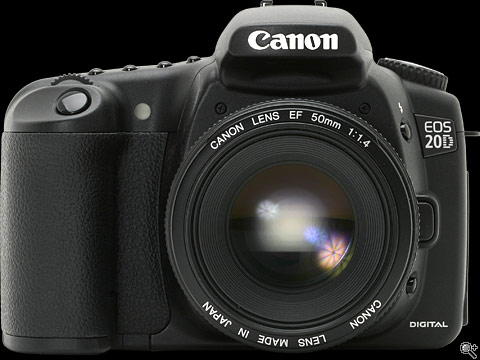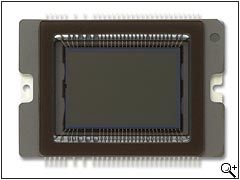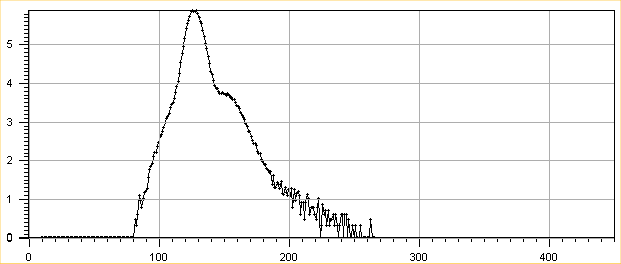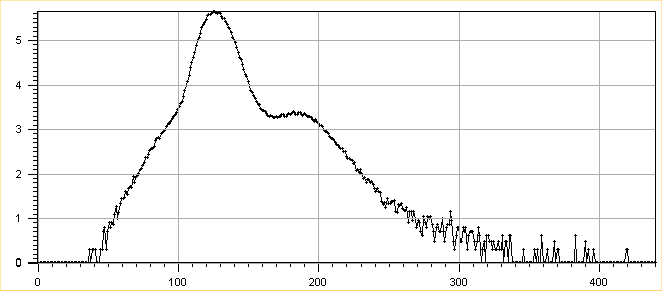
EOS 20D CMOS detector characterization
- noise and dark current -
The EOS 20D digital camera has been launched since september
2004 (a general review can be seen here)
and seem to have a very nice 8.2 million pixel CMOS detector. This page has been written in January 2005.
Some detector tests and characterization have been carried out to according
to the classic method described
here (used at ESO). The CR2 RAW file have been used to test the digital
camera output data and the PRISM
software used to reduce the data.

EOS20D CMOS detector in a nutshell

CMOS 8.2 millions pixels, read within 200 ms : 41 millions pixels per second
(5 fps)
Pixel size : 6.5 x 6.5 µm
RGB Bayer Color array detector
Max Dynamic output dynamic : 4095 ADUs (12 bits)
Measurement results
ISO 100
Readout noise: 2.3 ADU (28 e- readout noise)
Bias Level : 128 ADU
Gain : 12.3 e-/ADU (two flats method, green channel, 80% dynamic)
Dynamic (e-/pixel) : 50300e-
ISO 400
Readout noise : 2.6 ADU (9.1e- readout noise)
Gain : 3 e-/ADU (two flats method, green channel, 80% dynamic)
Bias Level : 128 ADU
Dynamic (e-/pixel) : 12300e-
ISO 800
Readout noise : 3.5 ADU (5e- readout noise)
Bias Level : 128 ADU
Gain : 1.45 e-/ADU (two flats method, green channel, 80% dynamic)
Dynamic (e-/pixel) : 6000e-
Some linearity measurements have been achieved, the green pixels have been used to make the following plots :

Up to 3800 ADU, the linearity is pretty good !
The light source was the roof of my office, so not so stable lightening conditions, explaining the jumps of the plot.
A 120s dark exposure shows that the pixel spreads out only from 100 to 200 ADUs

Y axis : Amount of pixels (Log 10)
X axis : ADU count
ISO 1600
Readout noise : 5.2 ADU (3.9e- readout noise)
Bias Level : 128 ADU (whatever the exposure time (long exposures >1s))
Gain : 0.8 e-/ADU (two flats method, green channel, 80% dynamic)
Dynamic (e-/pixel) : 3150e-
The Dark current has been measured also, at ISO 1600 and at room temperature (i.e. 20°C).
Exposure time (s) |
Dark current level at 20°C (ADU) |
Dark current noise (ADU) |
Calculated dark current level (e-/pixel) |
e-/pixel/second |
pA/cm² |
1 |
2 |
3 |
4 |
5 |
|
10 |
0.6 |
2 |
2.3 |
1.3 |
0.5 |
60 |
0.3 |
4.76 |
13.43 |
0.28 |
0.1 |
120 |
-0.55 |
7.1 |
30 |
0.25 |
0.1 |
Column 1 :
Dark current levels for different exposure time have been measured, despite
a 60s exposure, the level does not change, which is impossible. It looks like
an offset adjustment is done by the embedded DIGIC II processor. This method
cannot be applied and turns to be not relevant. so let's use the noise level
instead.
Column 2 :
Dark current noise level has been used instead, by acquiring many dark frame
and measuring the same pixels. Readout noise has been removed and the dark current
noise is increasing according to the exposure time, so the method is valid.
Column 3 :
Dark current level is computed by using the noise level (col. 2) and 0.77 e-/ADU
gain.
Column 4:
Dark current level expressed in e-/pixel/second is calculated. At 60 and 120s
exposure time the level is the same around 0.25 e-/pixel/sec. At 10s, the dark
current is too low and the measurement is corrupted by readout noise.
Column 5:
A figure expressed in pA/cm² is then computed. The figure is extremely
low, compared to Kodak CCD that exhibits in a same conditions about 10 pA/cm²,
i.e. 10 times more !
.
Dark frame, 120s exposure, ISO 1600
Bias frame, 120s exposure, ISO 1600
A 120s dark exposure shows that the pixel spreads out only from 75 to 300 ADUs

Y axis : Amount of pixels (Log 10)
X axis : ADU count
General comments
The measurements shows impressive figures, especially at a readout rate of
41 Megapixels : 4e- noise readout (ISO 1600) and 0.28e-/pixel/sec. I don't know
whether or not the detector is read out from a single port ... nevertheless
these are, still, impressive figures. Linearity is also very nice for a large
consumer market product. I've been to a CCD-CMOS workshop in 1999, in Japan,
where I met a guy from CANON. He said to me that "CCD will be dead soon,
and will not reach the SLR camera market; we aim at designing the best detector
ever for still photography, .. in CMOS technology"... I believe, it has
turn his wish to reality.
From these tests, a question may anyway arise from this : how far the DIGIC
II embedded processor is involved in changing the data from the detector to
make "nicer" the images ? It is true raw image from the CMOS detector
?